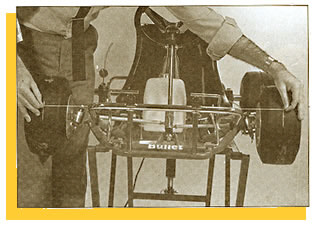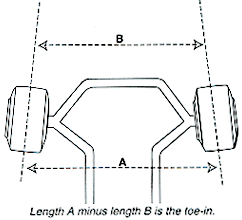|
IS
YOUR KART PIGEON-TOED OR BOW-LEGGED?
Printer-friendly format
By
John Copeland
I'm pretty sure
everybody has heard the term "toe-in" and that we all
know that it's something that needs to be adjusted for you kart to
handle properly. But just what that adjustment should be,
and how to set it, are, for many karters, a lot less clear. Let's
take a few minutes and look at the factors that determine what the
toe-in (or toe-out) setting should be, and how to make sure we get it
there.
 In
brief, toe-in is exactly what it sounds like: the amount the front
tires are closer together at the front edge than they are at the
rear edge of the tire. From a purely straightaway speed
perspective, it would seem that running zero toe-in would give the
least tire scrubbing, the least drag, and the maximum top end. But
virtually every chassis manufacturer recommends dialing in some small
amount of toe-in. Why is that? And are there ever conditions when
you'd want to run toe-out? How much toe-in is too much? Most
of the answers to these questions are based on the geometry of the
front end of the kart. In
brief, toe-in is exactly what it sounds like: the amount the front
tires are closer together at the front edge than they are at the
rear edge of the tire. From a purely straightaway speed
perspective, it would seem that running zero toe-in would give the
least tire scrubbing, the least drag, and the maximum top end. But
virtually every chassis manufacturer recommends dialing in some small
amount of toe-in. Why is that? And are there ever conditions when
you'd want to run toe-out? How much toe-in is too much? Most
of the answers to these questions are based on the geometry of the
front end of the kart.
Modern
race karts virtually all use between 9 degrees and 15 degrees of
castor in the spindles. That is, the kingpin lays back from
the vertical on each side. That means that when you turn the wheel
to the left, for example, as the left side tire moves back, it also
moves down. That's the major source of the corner to corner weight
transfer that helps the kart turn. "Fine," you say,
"What does that have to do with toe-in on the straightaway?"
Well, as you go down the straight, the steering constantly moves
left and right a tiny bit as the tires track over irregularities
in the surface. Setting in a little bit of toe-in helps keep
the front of the kart from weaving as it goes down the track,
"hunting" it's called. I know it's hard to believe that
just a 1/8th, or even a 1/16th of an inch will help keep the kart from
"hunting," but it will. Of course, you don't want
to run any more than necessary, because more toe-in generates more tire
scrub and cuts down on your chute speed. I can't recall any
manufacturer or tuner recommending more than 1/8th inch toe-in, usually
a lot less.
 If
we know, then, that a little bit of toe-in helps keep the kart
stable on the straights, what happens in the turns? Increasing
toe-in increases the slip angle on the outside front tire. The slip
angle is the difference between the direction the tire is pointed
and direction it is actually moving. Increasing the slip angle
increases the front cornering force and, consequently, moves the kart
towards an oversteer condition. Conversely, reducing toe-in, or
even going into a toe-out configuration decreases the slip angle on the
outside front tire, decreases cornering force in front and induces
understeer. If
we know, then, that a little bit of toe-in helps keep the kart
stable on the straights, what happens in the turns? Increasing
toe-in increases the slip angle on the outside front tire. The slip
angle is the difference between the direction the tire is pointed
and direction it is actually moving. Increasing the slip angle
increases the front cornering force and, consequently, moves the kart
towards an oversteer condition. Conversely, reducing toe-in, or
even going into a toe-out configuration decreases the slip angle on the
outside front tire, decreases cornering force in front and induces
understeer.
Setting
the toe-in properly is vital to proper chassis performance.
With the dimensions being so small, making toe-in adjustments correctly
is critical. There are lots of devices on the market to make the
job easier and more precise, but you can do it without anything more
than a tape measure and a screwdriver. With the kart up off the
track, on a stand or whatever, give the front wheels a hard spin, one at
a time, and scribe a straight line on the tire with the screwdriver
on the face of the tire as it spins. This is easiest with new
tires, but if you do it with tires that have been on the track it will
help if you clean them off first. Now you can carefully measure
the distance between the line on the left tire and the line on the right
tire. Whatever amount the lines at the front of the tires is
closer together than the lines at the rear is the amount of the toe-in.
The
biggest mistake lots of karters make when setting their toe-in is
that they don't take into account the change that occurs when the
driver's weight is in the kart. Putting the driver in the kart
flexes the frame down, taking the lower steering shaft support with it.
That effectively makes the correct distance between the steering
arm on the steering shaft and the steering arm on the spindle longer.
Since the tie rod didn't magically change length, the kart is now
toed-out, relative to where you set it on the stand. You can do
the experiment and determine exactly how much it changes on your kart
with your driver's weight, and then just remember to apply that
correction factor every time you set or check the toe-in on the stand.
But a better policy is to get in the habit of checking the set-up with
the kart on the ground and the driver in it. I can't tell you the
number of times I have heard karters complain that, even through they
set the toe-in right where the manufacturer or their dealer told them,
their kart wandered down the straights and understeered in the corners.
You can almost bet they set the toe-in on the stand and never thought
that it might change.
So
pull out the tape measure and make sure you've got the toe-in
set-up properly. Remember, if you want to get to the front, you've
got to point the kart there. See you next month.
About
Us | Karts | Parts |
Schedules | Resources | Contact
|